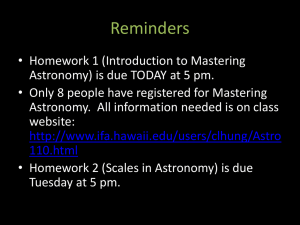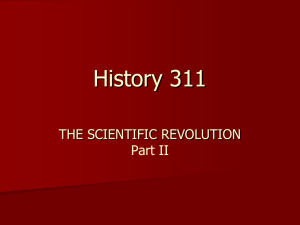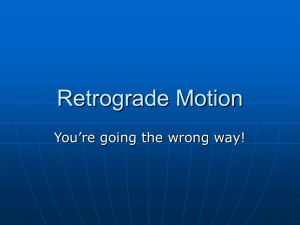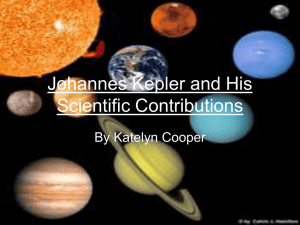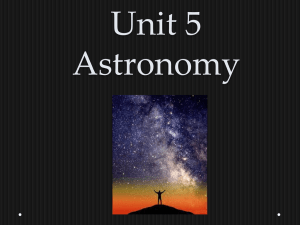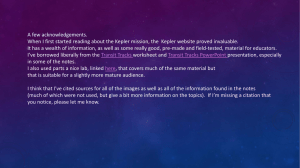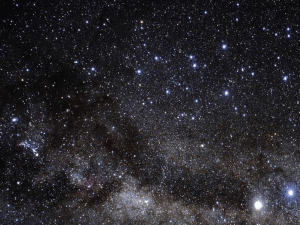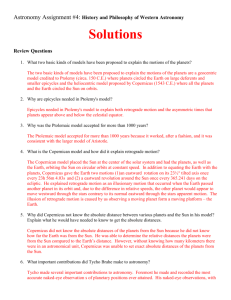Presentation for perspective graduate students 2006
advertisement
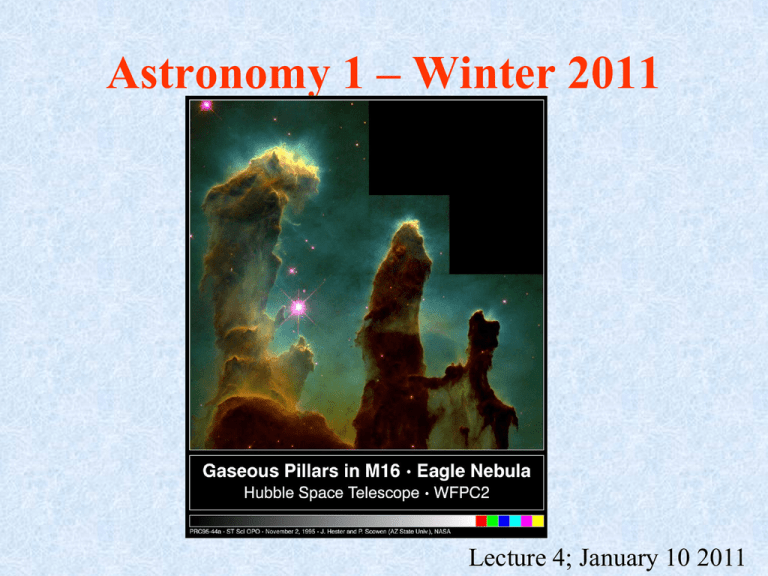
Astronomy 1 – Winter 2011 Lecture 4; January 10 2011 Previously on Astro-1 • Lunar Phases: – How do they arise? • Length of the Month: – How long does it take for the moon to go around the Earth? • The Moon’s Orbit: – Why don’t we have lunar eclipses every month? • Solar eclipses – What kind of solar eclipses are there? When do they happen? Today on Astro-1 • • • • • The motion of planets Geocentric Models Heliocentric Models Testing Models: Galileo’s observations Ancient studies of moon and sun’s orbit The ancient Greek (wrong) notion of planetary motion But sometimes the motion of planets is “retrograde” Can’t explain this with simple “perfect” circular motion of the planets The Geocentric explanation of retrograde motion: circles within circles – epicycles. Question 4.1 (iclickers!) •Planets move past the background stars as seen by someone of Earth. What is the normal direction of this motion? •A) East to West because of the motion of the planet along its orbit •B) East to West because of the rotation of Earth •C) West to East because of the motion of the planet along its orbit •D) West to East because of the motion of Earth along its orbit Copernican Revolution Nicolaus Copernicus (1473– 1543): revolutionized our understanding of our place in the universe by introducing the heliocentric (suncentered) model of the solar system. De Revolutionibus was published in 1543, but he had been circulating the ideas for 30 years. Aristarchus suggested a heliocentric model in the 3rd century BC, but it didn’t catch on. Heliocentric explanation of retrograde motion Maximum greatest elongation for Venus is 45°, and for Mercury 28°, so they can never be farther than that from the sun. Question: You see a very bright planet at midnight (you know it is a planet, because planets don’t twinkle like stars do). Is it Venus? Answer: Venus can never be farther than 45° from the sun. Since there are 360° in the sky, and it rotates in 24h, the celestial sphere rotates at 360°/24h=15°/hr. If Venus is at greatest eastern elongation, it will set 45°/(15°/hr) = 3hr after sunset. So it can’t be seen at midnight. Tycho Brahe (1546–1601) Here shown at Uraniborg, one of the two observatories that he built under the patronage of Frederik II of Denmark (though the telescope had not yet been invented). Kepler later used Tycho’s exquisite measurements. From Tycho’s Stella Nova Parallax: Tycho Brahe argued that if an object is near the Earth, an observer would have to look in different directions to see that object over the course of a night and its position relative to the background stars would change. Tycho failed to measure such changes for a supernova in 1572 and a comet in 1577, and concluded that these objects were far from the Earth. Question 4.2 (iclickers!) •Retrograde motion of a planet when viewed from Earth is caused by •A) The relative motions of Sun and planet •B) Its elliptical orbit path •C) The relative motion of Earth and planet •D) The inclination of its orbit to the ecliptic plane Astronomy picture of the day Question 4.3 (iclickers!) •Copernicus used the fact that Mars can sometimes be seen high in our sky at midnight to conclude that •A) Earth can come between Mars and the Sun •B) Mars and the Sun can never be on the same side of Earth at the same time •C) Mars can come between Earth and the Sun •D) The Sun can come between Earth and Mars Kepler Laws Johannes Kepler (1571–1630) By analyzing Tycho Brahe’s detailed records of planetary positions, Kepler developed three general principles, called Kepler’s laws, that describe how the planets move about the Sun. Kepler was the first to realize that the orbits of the planets are ellipses and not circles. Kepler’s first law: The orbit of a planet about the Sun is an ellipse with the sun at one focus. Kepler’s second law: A line joining a planet and the Sun sweeps out equal areas in equal intervals of time. Significance of Kepler’s Laws: Could describe the motions of the planets more accurately than any scheme before. Simpler than epicycles (so satisfies Occam’s Razor). Helped to justify the heliocentric model. http://apod.nasa.gov/apod/ap030714.html Question 4.4 (iclickers!) •Which of the following statements is true according to Kepler’s third law? •A) The smaller the orbit, the longer it takes for the planet to complete one revolution •B) The smaller the radius of a planet the more rapidly it rotates on its axis •C) The larger the orbit the longer it takes for the planet to complete one revolution •D) The time to complete one revolution of its orbit depends on the size or radius of the planet Testing Models Galileo Galilei (1564–1642) Galileo was one of the first people to use a telescope to observe the heavens. He discovered craters on the Moon, sunspots on the Sun, the phases of Venus, and four moons orbiting Jupiter. His observations strongly suggested that the Earth orbits the Sun, not vice versa. Numbers are angular size of Venus in arcsec, but mistakenly labeled as degrees in figure. Early Observations of Jupiter’s Moons In 1610 Galileo discovered four “stars” that move back and forth across Jupiter from one night to the next. He concluded that these are four moons that orbit Jupiter, much as our Moon orbits the Earth. This drawing shows notations made by Jesuit observers on successive nights in 1620. The circle represents Jupiter and the stars its moons. Arguments favoring Heliocentrism over Geocentrism •Observations: •Phases of Venus •Stellar Parallax •Against specific feature of Ptolemy’s model •Moons of Jupiter •Sun spots •Moon spots •Occam’s razor: simpler explanations of phenomena are more likely to be correct. (“Razor” refers to shaving extraneous details from an argument) Question 4.5 (iclickers!) •The one significant observation Galileo made through his home-built telescope that convinced him that the planets revolved around the Sun was •A) the appearance of the Milky Way as a mass of individual stars •B) The discovery of rings around the planet Saturn •C) The appearance of mountains and craters on the Moon •D) That the appearance of Venus followed a cycle of phases, from crescent through quarter and gibbous phases to full phase Summary • Planets appear to move on the sky mostly West to East but occasionally with “retrograde motions” • The ancients thought that the Earth was at the center of the solar system and that planets moved in spheres around the Earth – epicycles explained retrograde motion • In the modern Heliocentric model, the planets go around the sun (copernican model) – What pieces of evidence show that the Geocentric model is false? • Kepler’s Laws – The orbits of planets are ellipses – A planet’s speed varies along the orbit – The period of the orbit is related to the size of the orbit The End See you on Wednesday!
